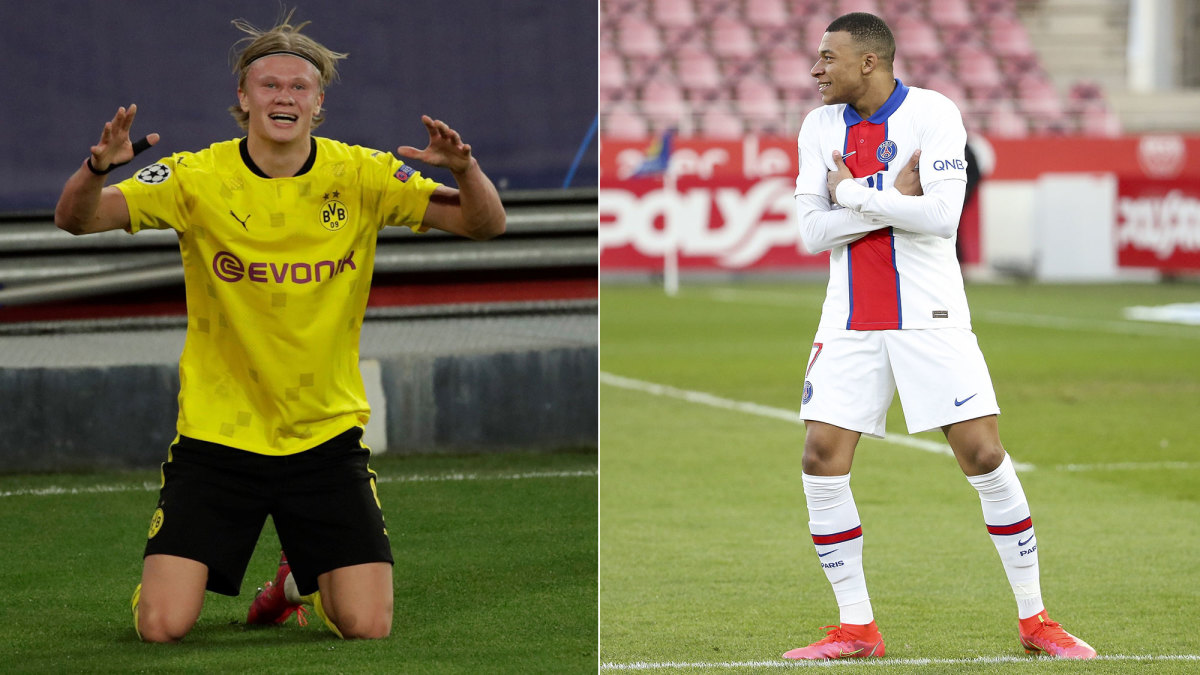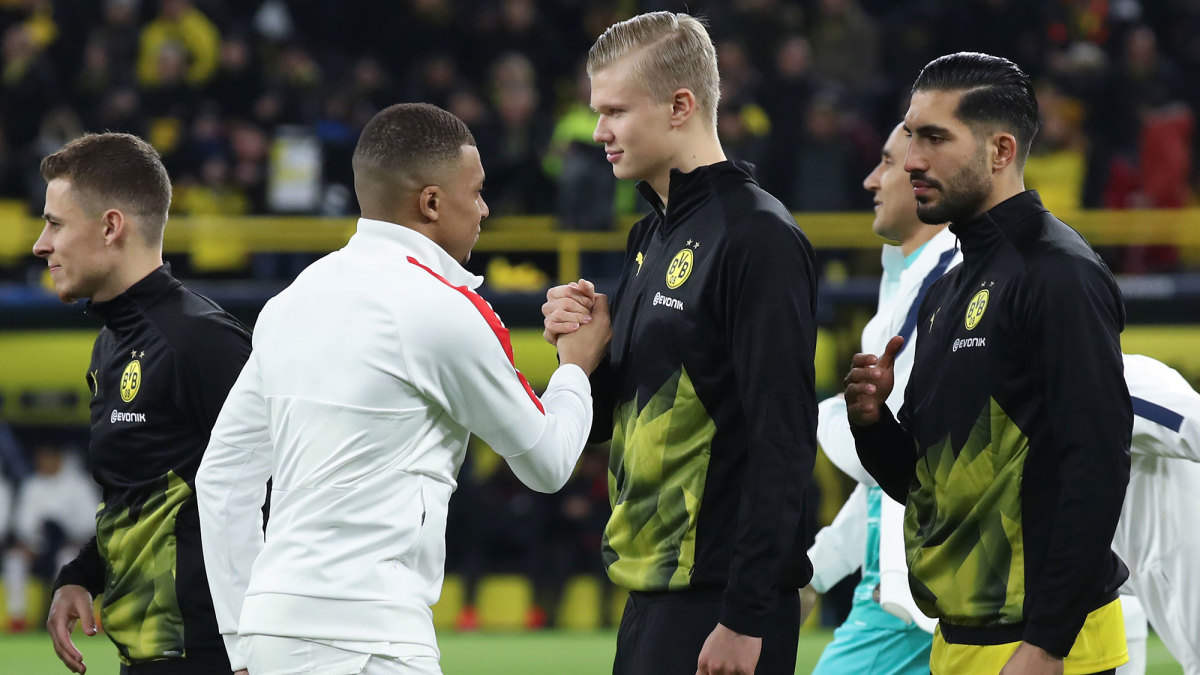What the Stats Say About the Budding Mbappé vs. Haaland Debate
Erling Haaland and Kylian Mbappé have played fewer than two full matches on the same pitch. The young forwards have seen the field together for a total of just 116 minutes. Yet a few years into their respective professional careers, the two are inextricably connected, one seldom mentioned without the other.
Both blossoming and both electric, the pair’s penchant for appearing in debates is growing eerily reminiscent of that of a certain older attacking duo (see: Ballon d’Or winners, 2008–2017 and 2019). So how does one decipher the argument between the two rising superstars?
Context, as always, is key. In a vacuum, comparing their raw numbers paints a crystal clear picture of juxtaposition. But this isn’t a vacuum. These are two real players playing slightly different positions for clubs of different statures in different leagues.
We’ll start with Haaland, the 20-year-old Borussia Dortmund center forward. Next to no striker in the relatively recent history of reliable soccer statistics has recorded an age-20 season of the quality of Haaland’s since Brazilian great Ronaldo. Playing at Inter in 1997, he scored 31 goals in all competitions for the Italian giant a year after scoring 34 goals for Barcelona. Haaland already has 31 in all competitions with nine more Bundesliga match weeks and at least three more domestic and international cup appearances remaining. He’ll turn just 21 come July.
None of Europe’s current top strikers—Bayern Munich goal machine Robert Lewandowski included—possessed remotely the same goal-scoring prowess of Haaland at his age. With that in mind, Haaland has reached the point in which comparison to Europe’s best strikers right now is more productive than comparison to when they were also in their early 20s.
The 32-year-old Lewandowski is the only striker in Europe’s top five leagues with more club goals in all competitions this season. Where Haaland has distinguished himself, even at such a young age, is his shocking finishing numbers. He has scored 10 more non-penalty goals than he has xG, meaning he’s finishing at a significantly higher rate than what his “expected goals” predict. That differential is greater than Lewandowski’s and far superior to that of any other top European striker.
Haaland’s exquisite finishing has shone brightest in the UEFA Champions League. He has the most goals in the competition (10) despite being second in xG (6.0)—and despite missing two games in the group stage. He recently became the fastest player to reach 20 goals in the competition, doing it in a mere 14 matches. A competition that has been dominated by Cristiano Ronaldo and Lionel Messi for years may just have its new face.
But what differentiates Haaland from Europe’s other elite center forwards is what he’s asked to do. Like Lewandowski in his early years, Haaland isn’t always blessed with a silky-smooth touch on the ball, his 6' 4" frame sometimes getting in its own way. But because of his ability in front of goal, his role at striker more closely resembles that of, say, Leicester City’s Jamie Vardy rather than that of Lewandowski or Ronaldo.
Compared to counterparts at Europe’s biggest clubs, Haaland hasn’t done much in the buildup or defensively. He’s completed just 440 passes this season, compared to Lewandowski’s 716 or Harry Kane’s 746. He isn’t prolific in his creation for others or his work on the ball (he’s completed less than one dribble per game). So instead of taking on responsibilities behind the ball, Haaland is as pure a target man as they come.
Even so, next to nobody has been able to equal his production in this spot. Even Cristiano Ronaldo, the eternal anomaly, hasn’t matched Haaland’s scoring numbers. The Norwegian wonder boy is simply as hot a finisher as there is right now in the world.

If Haaland’s game is the lead role in a symphony, then the 22-year-old Mbappé’s is a one-man band. The Frenchman has been deployed at center forward, on both wings and as part of a two-striker system. It doesn’t seem to matter where he plays—he produces goals and creates chances galore. That said, most of his appearances under new manager Mauricio Pochettino have been on the left flank. So for the sake of this exercise, let's compare Mbappé to Europe’s crop of wingers.
As with Haaland, it’s hard to compare Mbappé’s youthful greatness to just about anyone. For instance, a young Messi scored 15 goals and recorded three assists in his age-19 season. Mbappé scored 39 and assisted 15 en route to winning Ligue 1 Player of the Year back in 2019.
While Haaland is no slowpoke, Mbappé has made headlines with his blazing speed, clocking in at 22.4 miles per hour multiple times in the last year. But he’s not just a burner without skill on the ball. Mbappé’s 9.36 progressive carries per 90 minutes are in the 93rd percentile of all attacking midfielders and wingers, according to FBref.com. He produces chances for others on par with the elite, too; his 4.39 shot creating actions per 90 minutes are more than Ronaldo, Mohamed Salah, Raheem Sterling and Sadio Mané.
Mbappé’s only “issue” in the midst of an otherwise superb season has been his finishing. While most other top forwards have scored more than their xG, he’s scored 17 non-penalty goals in Ligue 1 and Champions League play compared to an 18.1 xG. But if you think that’s a problem, you may want to consult Barcelona.

So it comes down to this simple question. Which is more valuable: a finishing machine who scores more goals than he should, or a plug-and-play speedster that can create from anywhere on the field?
Versatility shouldn’t be overlooked. Both players like to play on the break, but Mbappé’s ability to start a counter and finish on the other end may give him the edge. With him on the pitch, PSG creates far more chances (1.05 xG more) than when he’s on the bench. Dortmund has a net xG differential of just 0.59 with Haaland on.
If the stars align for Friday's Champions League quarterfinal draw, there may be a rematch of last year’s spectacular round-of-16 tie, in which a first-leg brace by Haaland against Mbappé and the Parisians burst him onto the scene.
If not, then we may have to wait until Haaland inevitably joins one of Europe’s richest super clubs to see the two go at it. But whenever they do meet again, don’t waste your time trying to compare. Enjoy it. These budding stars are truly, well, two of a kind.
